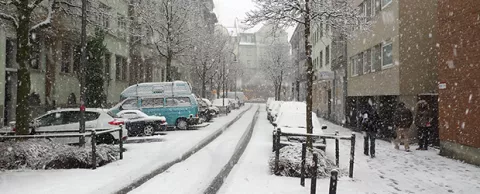
Cities really are in the customer service business. Thus, when it snows and residents can’t get to where they need to go, it’s the city’s problem. Just ask former Seattle Mayor Greg Nickels. According to Grist Magazine, he lost his 2008 re-election bid because of “a botched response to a snowstorm… City plows cleared the mayor’s neighborhood but few other streets.”
But plowing snow is expensive and time consuming. Enter data analytics. As you’ll read below, through more efficient and adaptive route planning, Centennial, CO cut its plowing expenses by nearly half. And residents are happier than ever.
And this doesn’t just apply to snowplows. From potholes to large infrastructure projects, using analytics is a great way to be a star to those you serve. — Jesse Berst
Snowplows for half-price
Council Lead Partner CH2M used a variety of technologies — some high-tech, some consumer-grade — to do away with Centennial’s old, inefficient snowplow routes and replace them with something that’s much more efficient and responsive.
Each snowplow is tracked with a regular GPS unit and all the data is fed into an analytics system that plots the most efficient route, giving priority to high-traffic areas that actually need to be cleared.
The result? The snowplowing time was cut by 40%. During a typical route, the city’s snowplows cover twice as much area as those from neighboring cities. It’s like getting two snowplows for the price of one.
More adaptive budgeting
The savings not only get more people to work on time, but they result in higher-quality road surfaces throughout the year.
Centennial has an overall road contract with CH2M, so any savings that result through more efficient plowing are poured into addressing other road projects. For example, the less that’s spent on snowplowing, the more that’s available for road striping.
The contract is flexible, so if the city has a mild winter, it’s not paying for snowplowing services that it doesn’t need. This kind of approach may especially make sense for your city if there can be some significant variation in your needs year to year.
Putting the customer (citizens) first
Ultimately, customer service is the top priority in any initiative like this, and one key component of the program is a single hotline that people can call to report problems. Hotline staff take note of the problem and route it to the team that can address it. They also make sure to take down the caller’s name and phone number so they can get back to them with progress updates.
The phone line is open around the clock. Residents can also submit issues online.
The effort is paying off with much higher citizen satisfaction scores. During the latest survey, nearly 80% of those responding rated their quality of life in the city “good” or “excellent.”
More stories …
How to make your highways talk to you (so you can save money on repairs)
How Los Angeles uses maps to help the city run more smoothly
How Minneapolis is taking the guesswork out of running a city



